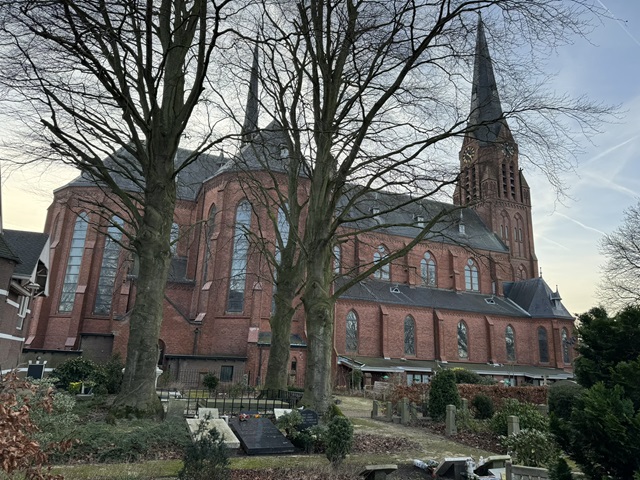
Kerkstraat 77
Open van 11.00 – 16.00 uur

De imposante Rooms-Katholieke Sint Willibrorduskerk werd in 1905 officieel geopend. Het is een basilicale kruiskerk (op kruisvormige grondslag) die is opgetrokken in rode baksteen in neogotische trant. De architect is Nicolaas Molenaar (1850-1930) die een groot aantal kerken in deze stijl heeft gebouwd. In 1905 stonden er twee kerken bij elkaar: de nieuwe kerk en een oudere kerk, die in 1906 werd afgebroken. Op de plaats van de oude kerk werd een verenigingsgebouw gebouwd, eveneens ontworpen door Molenaar, het huidige cultureel centrum Warenar.
Wassenaar is vanouds een katholiek dorp. Na de Reformatie aan het eind van de zestiende eeuw werd de katholieke leer door de overheid onderdrukt. Katholieken mochten wel hun godsdienst belijden, maar niet in het openbaar. Ze werden veroordeeld tot bijeenkomsten in schuilkerken: kerken die waren ondergebracht in particuliere huizen en in boerenschuren. In de zeventiende eeuw werd een gedeelte van een grote boerderij aan de latere Kerkstraat ingericht als kerkruimte. In 1727 werd op deze locatie een echte kerk gebouwd. Ernaast verrees een grote pastorie. Deze kerk werd in de negentiende eeuw vergroot.
In de negentiende eeuw mochten de katholieken zich eindelijk weer optimaal manifesteren. Door heel Nederland werden nieuwe, monumentale katholieke kerken gesticht. Dat het toenmalige boerendorp Wassenaar in 1903-1905 zo’n grote kerk kon laten bouwen, was te danken aan de toenmalige pastoor Joannes Jacobus Bruijstens (1830-1906) die zo rijk was, dat hij het kerkgebouw uit eigen zak kon bekostigen. Ook financierde hij de naastgelegen pastorie, een riante woning die nu dienstdoet als hospice. Bovendien schonk pastoor Bruijstens de zusters Franciscanessen van Oirschot een nieuw klooster in de Kerkstraat (1900). Ook de pastorie is ontworpen door Nicolaas Molenaar.
De Sint Willibrorduskerk kreeg de gedaante van een middeleeuwse kerk. Het interieur was bijzonder kleurrijk dankzij bonte muurschilderingen, vijftig glas-in-loodramen en verschillende heiligenbeelden. Helaas werd het oorspronkelijke interieur in 1960 als verouderd beschouwd. Bepaalde onderdelen, zoals het tabernakel en de opbouw van het altaar werden verwijderd en de gekleurde pilaren en wanden werden gewit. Een tweede restauratie in 1980 bracht gelukkig de oude glorie gedeeltelijk weer terug. Een lust voor het oog zijn nog steeds de glas-in-loodramen die vervaardigd werden door de ateliers Otto Mengelberg en H.A.M. de Vos in Utrecht en F. Nicolas en Zonen in Roermond.
Tekst: Robert van Lit
Saint Willibrord Church

Kerkstraat 77
Open from 11 a.m. – 4 p.m.

The imposing Roman Catholic St. Willibrord’s Church was officially opened in 1905. It is a basilical cruciform church (on a cruciform base) built in red brick in neo-Gothic style. The architect is Nicolaas Molenaar (1850-1930) who built many churches in this style. In 1905 there were two churches close together: the new church and an older church, which was demolished in 1906. On the site of the old church, a community building was built, also designed by Molenaar, the current cultural centre Warenar.
Wassenaar has traditionally been a Catholic village. After the Reformation at the end of the sixteenth century, Catholic doctrine was suppressed by the government. Catholics were allowed to practice their religion, but not in public. They were condemned to meetings in secret churches: churches housed in private houses and in barns. In the seventeenth century, part of a large farm on what would later become Kerkstraat was converted into a church space. In 1727, a real church was built on this site. A large rectory was erected next to it. This church was enlarged in the nineteenth century.
In the nineteenth century, Catholics were finally allowed to manifest themselves optimally again. New, monumental Catholic churches were founded throughout the Netherlands. The fact that the then farming village of Wassenaar was able to have such a large church built in 1903-1905 can be contributed to the then pastor Joannes Jacobus Bruijstens (1830-1906) who was so rich that he was able to pay for the church building out of his own pocket. He also financed the adjacent rectory, a spacious house now serving as a hospice. In addition, pastor Bruijstens donated a new convent in the Kerkstraat to the Franciscan Sisters of Oirschot (1900). The rectory was also designed by Nicolaas Molenaar.
St. Willibrord’s Church took on the appearance of a medieval church. The interior was particularly colourful thanks to polychrome murals, fifty stained-glass windows and several statues of saints. Unfortunately, the original interior was considered outdated in 1960. Certain parts, such as the tabernacle and the structure of the altar, were removed and the colored pillars and walls were whitewashed. Fortunately, a second restoration in 1980 brought back some of its former glory. The stained-glass windows that were made by the studios Otto Mengelberg and H.A.M. de Vos in Utrecht and F. Nicolas and Sons in Roermond continue to be a feast for the eyes.
Text: Robert van Lit
